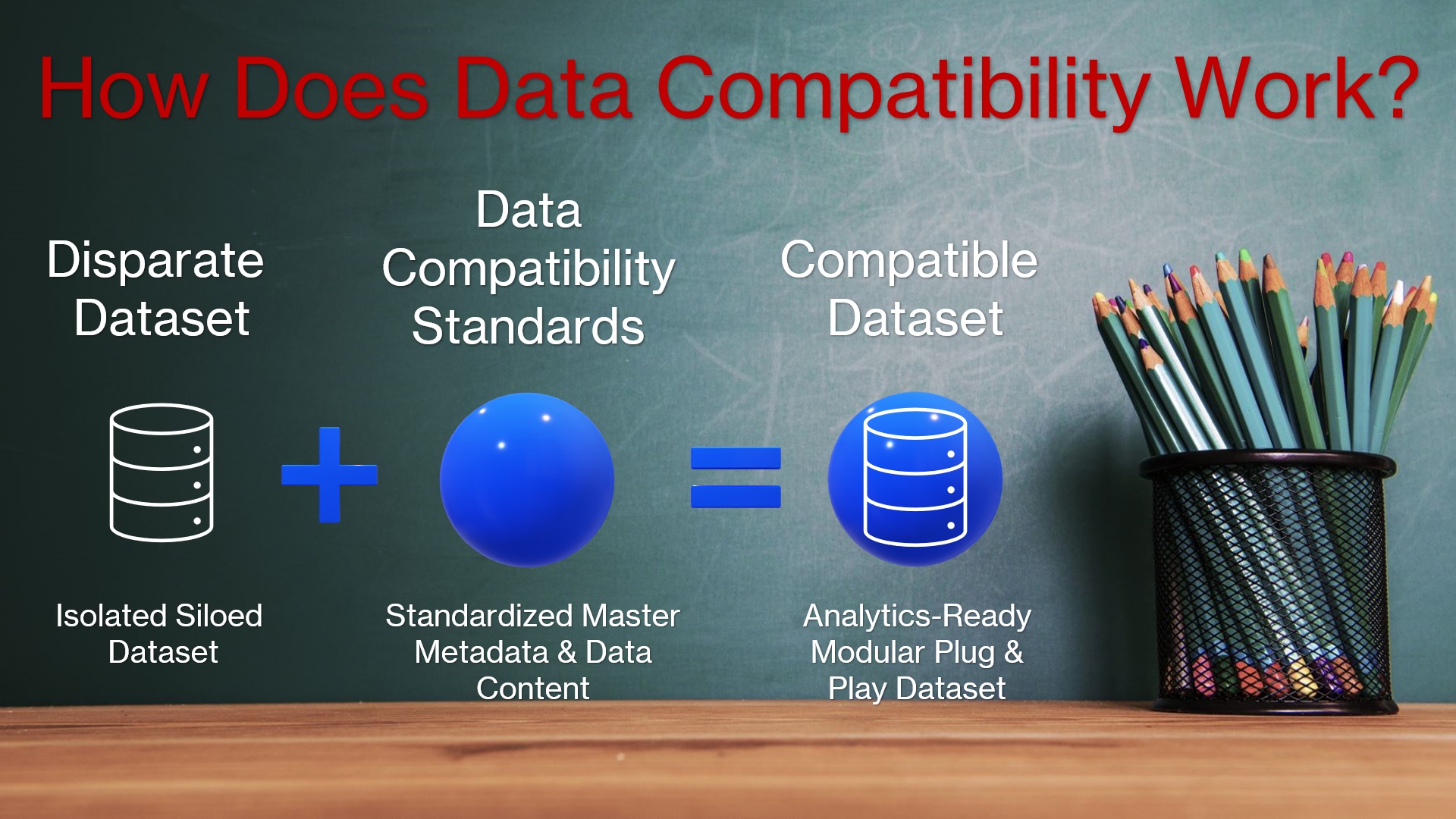From Disparate Datasets to Compatible Datasets by Simple Enrichment
Our research proves that disparate datasets are not directly interoperable simply because these datasets lack master data commonality and the proof is very simple! When Maxxphase Data Compatibility Standards are added to disparate datasets, these now-compatible datasets are directly interoperable. When the Maxxphase Data Compatibility Standards are removed from compatible datasets, they become disparate datasets. So, the transition from disparate or siloed datasets to directly interoperable compatible datasets is easy. Beyond the ease of dataset enrichment with Data Compatibility Standards, the enrichment can be done non-invasively, not changing any existing data content or structural metadata.

A Simple Equation Showing the Addition of Data Compatibility Standards to a Disparate Dataset
Each Data Compatibility Standard is designed to provide master data commonality for a specific master data domain when added to any dataset. When our patented Data Compatibility Standards enrich a disparate dataset, the dataset becomes compatible, modular, and directly interoperable with any other compatible datasets. When compatible modular datasets are consolidated, the resulting blended datasets are indistinguishable from a single integrated dataset. Maxxphase Data Compatibility provides the first data solution to this disparate data problem. Maxxphase Data Compatibility Standards and Methods are revolutionary in the IT industry.
The Master Data Compatibility Foundation
Most businesses struggle to obtain the integrated data they need to support their business processes. This lack of integrated data is caused by conflicts in the master data representations among their disparate datasets. The master data of traditional disparate datasets can be conflicted in many ways, such as metadata differences, structural differences, and inconsistent data values. Not imposing standards in master data representations across traditional datasets was a major mistake in how these conflicted datasets were initially designed and instantiated.
Master data compatibility across datasets does not happen by accident. Maxxphase Data Compatibility Standards provide a standardized target for the master data representations of each dataset to comply. Any dataset that complies with the Data Compatibility Standards is a compatible dataset. Data Compatibility Standards are also used to correct existing master data conflicts, making that dataset compatible. The master data compatibility imposed by Data Compatibility Standards provides a foundation of master data commonality that anchors compatible datasets relative to each other.
Data Compatibility Standards and Methods are the future for datasets in the information technology industry. A whole new world of data solutions is unlocked once your datasets become compatible!
The Secret of Direct Dataset Interoperability
Our products, Maxxphase Data Compatibility Standards, bring standardization to dataset design and development methods that have been too arbitrary for far too long. Our standards define a target state of master data commonality for the compatibility of all datasets. When our standards non-invasively encapsulate a dataset, that dataset becomes compatible. Our Data Compatibility Standards compose a standardized master data shell encapsulating each compatible dataset. This standardized master data shell makes compatible datasets modular. Our patented Data Compatibility Standards are specifically designed to support direct dataset interoperability. Beyond that, Maxxphase Data Compatibility Standards enrich datasets to be analytics-ready with all the functionality of a data warehouse.
Our Data Compatibility Standards are specifically designed to form reliable data access paths among these modular compatible datasets. These data access paths allow the computer to make the appropriate direct data record matches across datasets. In this way, any data from any compatible dataset may now be directly joined with the data of any other compatible datasets. The Maxxphase Data Compatibility Standards are the secret behind direct dataset interoperability.

Modular Analytics-Ready Compatible Datasets
At Maxxphase, we designed and developed Data Compatibility Standards to incorporate a data warehouse's functionality. When Maxxphase Data Compatibility Standards enrich a dataset, that compatible dataset now supports multi-dimensional analytics. In addition, any compatible dataset has the direct data interoperability needed to blend with any other compatible dataset. These interoperable compatible datasets become Compatible Data Warehouse plug-and-play modules. These modules are interchangeable and can be dynamically blended to form more business-relevant Compatible Data Warehouse modules. Consolidated data warehouse modules can be virtual or materialized to create a Compatible Data Warehouse.
Any dataset, structured, semi-structured, or unstructured may be made compatible. When a source dataset is standardized, it becomes a real-time data warehouse module. However, a compatible dataset may also be restructured to support a near real-time data warehouse component. In either event, these modular datasets will all be compatible, integrated, directly interoperable, and analytics-ready. Our patented analytics-ready modular plug-and-play datasets are far superior to the disparate datasets that are predominant in IT today.
The Compatible Data Fabric as a Data Architecture
For many organizations, the ultimate data architecture is a data fabric. However, attempting to construct a monolithic data fabric using conventional data transformation-based methods is ridiculously difficult and expensive.
The Compatible Data Fabric is composed of directly interoperable, analytics-ready, modular datasets. When a dataset is made compatible, it automatically becomes an integral component of the Compatible Data Fabric. Since compatible datasets are directly interoperable, there are no data movements and no data transformations required! Each compatible dataset is plug-and-play within the Compatible Data Fabric.
Compatible datasets are each encapsulated with a "shell" composed of Maxxphase Data Compatibility Standards. These dataset shells are designed and implemented to form a multitude of data access paths or threads that dynamically blend compatible datasets. This dataset blending creates a virtual analytics-ready compatible data fabric. All interactions among compatible datasets are identical and dynamic. As such, compatible datasets are designed to be additive. The Compatible Data Fabric will revolutionize digital data, information, and knowledge in the IT industry.
